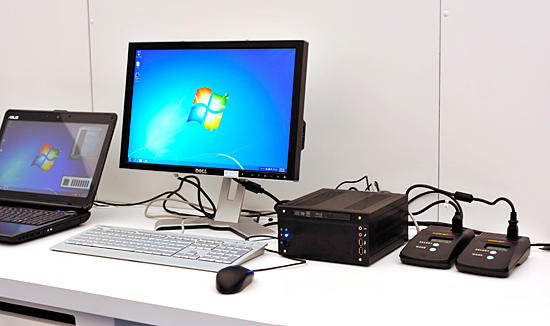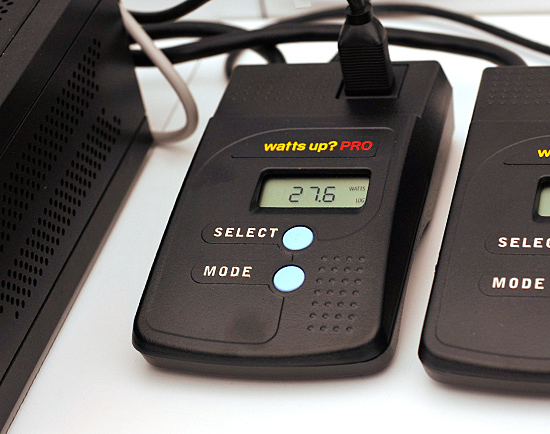The Real Conroe Successor: Clarkdale & All You Need to Know about Westmere
by Anand Lal Shimpi on September 24, 2009 6:00 PM EST- Posted in
- CPUs
Two Cores, Four Threads
Clarkdale is the spiritual successor to Conroe - one of our favorite dual-core processors of all time. It's a dual core chip but with all of the magic of Nehalem. Meaning you get a 64KB L1 per core, 256KB L2 per core but only a 4MB L3 cache. Remember that the L3 cache is shared among all cores and Intel likes to keep the ratio at 2MB per core.
Each core is capable of executing two threads (Hyper Threading). There's of course going to be turbo mode, although the upside shouldn't be too huge on desktop Clarkdale processors.

A Clarkdale mini-ITX system
Clarkdale, like the rest of the Nehalem/Westmere family makes extensive use of clock gating. You also get a ~1M transistor PCU that is in charge of keeping power consumption at a minimum. The result is a chip that truly sips power:

69.8W under Cinebench load
Intel's Clarkdale mini-ITX system used less than 30W at idle and only 70W under load running Cinebench's multi-threaded test. The idle performance is particularly impressive - that's not too far off from an Ion system honestly, but with much better performance.

27.6W at idle










96 Comments
View All Comments
wagoo - Saturday, September 26, 2009 - link
..with these 12 shaders you are really spoiling us!ClagMaster - Friday, September 25, 2009 - link
Clarksdale is not the spiritual successor of Conroe. If this is true then I fail to see it.Clarksdale with its dual core CPU and embedded graphics chip is obviously positioned for business and education Platforms. What Intel is attempting to do is include a high speed GPU with low latency interconnects to the CPU, memory and PCIe. To improve memory latency for the GPU and maximize its performance, the memory controller is placed on the GPU die instead of on the CPU die. This makes perfect sense for a business platform processor. But it makes no sense at all for a mainstream or enthusiast processor.
Additional evidence that Clarksdale is positioned for business and education platforms is the much touted AES-NI encryption acceleration. This is wonderful for business and government, but generally worthless to high-end mainstream and enthusiast users. I certainly could not care less about these new instruction sets.
I share TA152Hs disgust and horror over moving the memory controller from the CPU to the GPU.
I am disappointed. Clarksdale is not a processor I would want. I would much rather have Lynnfield shrunk to 32nm with incremental improvements to the memory and PCIe controllers. The reason why this has not happened is because of that GPU included with Clarksdale. Two CPU’s with hyperthreading (4 threads) will never outperform four CPU’s with no hyperthreading. I would be better off with an i7 860 than with Clarksdale.
Gulftown is evidently another server chip design with desktop versions available for enthusiasts (in the Samuel Johnson sense of the word) with plenty of cash to squander. I agree with the observation the X58 is a dead-end money pit.
Intel may well be providing an opportunity for AMD. AMD will soon be providing a 32nm quad core Athlon II X4 CPU for high-end mainstream users that will challenge Lynnfield.
v12v12 - Monday, October 5, 2009 - link
I would much rather have Lynnfield shrunk to 32nm with incremental improvements to the memory and PCIe controllers. (Testing since the POS buttons don't EVER WORK!)I couldn't agree more... WTF, I like to consider myself a "smarter" shopper. Aka I like looking at road maps and plotting the best times to buy chips with most ground breaking innovations for my personal usage... And it WAS Lynnfield, UNTIL they balked at 32nm AND disabled (b/c they are greedy and AMD doesn't have a leg to stand on anyhow) HT... So now I'm stuck with a crippled 45nm Lynn Vs a Bloom-860 that SHOULDN'T even be on the market as far as I'm concerned... the Lynn 45nm PLUS HT = should be MY NEW CHIP (if I had to settle...) *Sigh* guess I'll be waiting some more on my old AMD rig... Thanks Intel...
CrimsonFury - Thursday, October 8, 2009 - link
The i7 860 is NOT Bloomfield based, its Lynnfield based (dual channel memory, intergrated PCI-E controller) on socket 1156. You want 4 cores and 8 threads (HT) in a more affordable package, there you have it.Personally I think Intel made a mistake creating the i5 750. They should have just called the 8xx series i5 to differentiate them from Bloomfield and left it at that until the i3 arrives.
PS. To add to the branding confusion, just found out from an Intel conference yesterday than the Clarksdale's with with vPro enabled (Dual core CPUs with HT) will be branded Core i5 ^_^
mozartrules - Saturday, September 26, 2009 - link
"I am disappointed. Clarksdale is not a processor I would want"Why did you ever think it would be. Most people on this site would not be interested in the Intel processor family that is just above the Atom. Lynnfield is the processor made for you. Of course it would have been nice to have a 32nm Lynnfield, but Intel cannot change all their factories at the same time.
Intel has an obligation to the shareholders and I don't think we need to look at their business plan to realize that the vast majority of processors are sold to people who would not choose a four core processor. The reality is that the vast majority of people has no need for a four core processor and they are unwilling to pay for it.
I am writing this on a 2GHz dual core laptop and that is overkill for what I do (I don't use games). I have a dual X5570 at work for Monte-Carlo simulations, but that is a completely different market. The latter will probably also point towards the expected Gulftown audience, $1000 is cheap when you were OK paying $1500 for the X5570!
Also remember that AMDs survival is crucial for Intel. Not just to fend off the monopoly charge but also to make sure that nVidia has a competitor. Letting AMD compete in the reasonably small area of people who build their own computers and overclock (less profit for the CPU manufacturer) may well be a good business decision.
ClagMaster - Monday, September 28, 2009 - link
The business of Intel is Business. Thats why they developed Clarkdale to address business needs for an efficient high performance chip. Its perfect for Business and Home Theater platforms.Your right, the Lynnfield is for me. My next upgrade in the Summer of 2010 will feature an i750/P55.
I too run Monte Carlo analysis (neutron/photon transport) on my PC at home and on superclusters featuring 100's of 4-processor servers. The i750/p55 is actually more capabile than the mainframe computers I was working with 25 years ago. Most of my CPU cycles are used for media conversion or monte carlo analysis. I use the power of overnight batch processing while I count sheep to get the most out of my PC. I get good statistics with the problems I run at home with my E6600/G965.
I agree the survival of AMD is crucial for Intel for the reasons you described.
smilingcrow - Saturday, September 26, 2009 - link
"AMD will soon be providing a 32nm quad core"Unfortunately this isn’t going to happen until early 2011 so it will be competing with whatever Intel has out by then.
ClagMaster - Saturday, September 26, 2009 - link
What Intel will have out in 2011 is the pricey Gulftown for pricey LGA1366 motherboards.I think a 32nm shrink of Athlon II X4 or X6 will occur sooner than you think.
Harry Lloyd - Friday, September 25, 2009 - link
Does the 24 Hz refresh rate finally work on Intel graphics? Will Clarkdale support it?MamiyaOtaru - Friday, September 25, 2009 - link
This leaves me pretty flat. I was waiting for a 32nm Nehalem so i could maybe finally get a quad core without a larger TDP than my dual core. But 6? So much for TDP not increasing too much. And there's no way I am getting another processor with 2 cores, especially not with integrated graphics. I don't need a bunch of silicon sitting there that I'm never going to use.My plan to wait for Westmere seems to be fail. I'll just stick with what I've got I suppose.